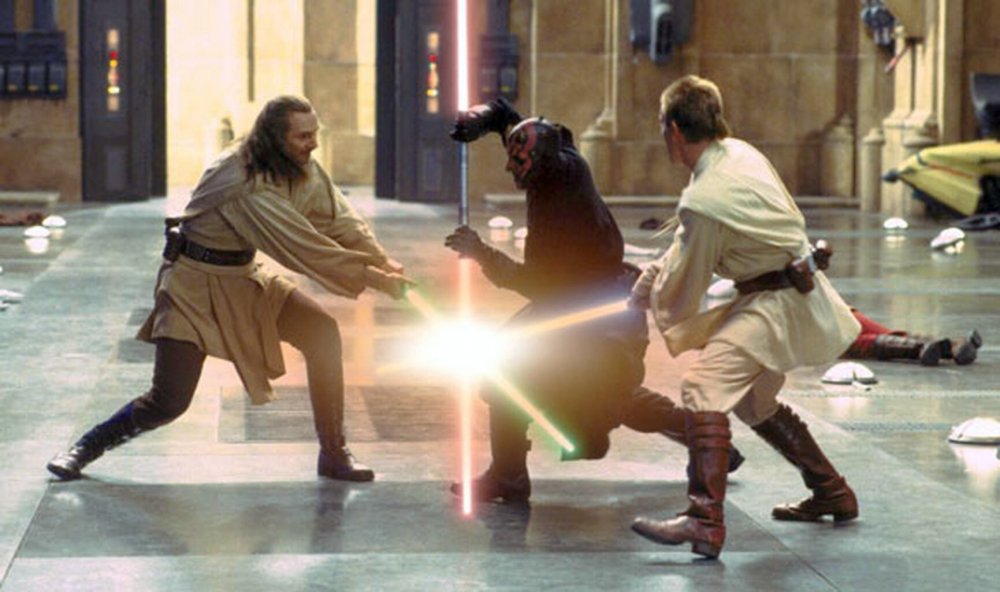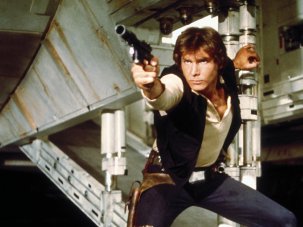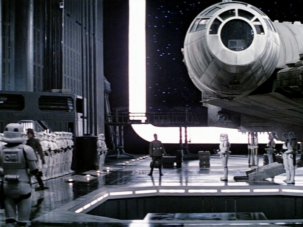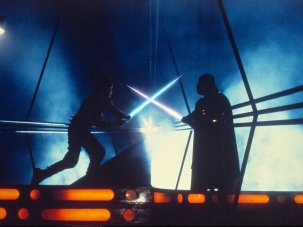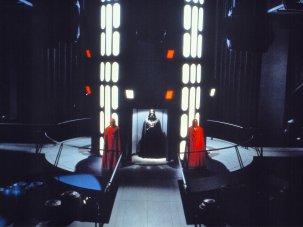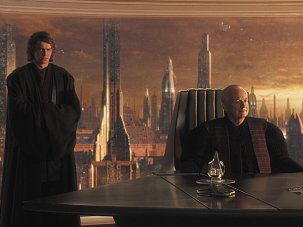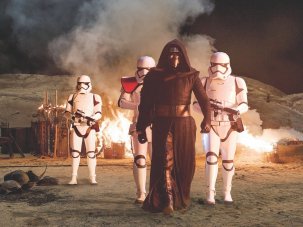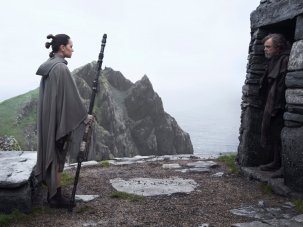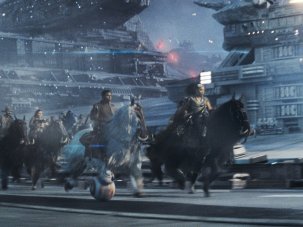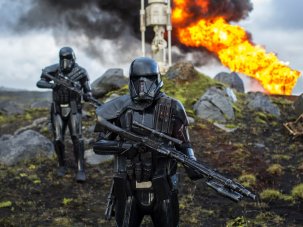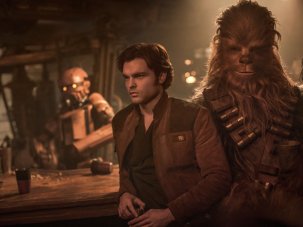Any film that begins with a seven-word title and then includes the words ‘taxation’ and ‘debate’ in its first five seconds is either a deadly historical epic about the American Revolution or is taking its audience for granted. I’m tempted to suggest Star Wars Episode I The Phantom Menace fits both of these criteria, but George Lucas’s allegories are so muddled it’s impossible to make sense of them. Start with a distinctive New World lust for ancient traditions of aristocracy and order, toss in a misguided effort at multiculturalism and season with the Aryan myth of racial purity, and you’ve got a murky, talky prequel that emphasises all the series’ weakest elements rather than its strongest ones.
USA 1999
Certificate U 131 mins approx
Director George Lucas
Cast
Qui-Gon Jinn Liam Neeson
Obi-Wan Kenobi Ewan McGregor
Queen Amidala/Padmé Natalie Portman
Anakin Skywalker Jake Lloyd
Shmi Skywalker Pernilla August
Yoda Frank Oz
Senator Palpatine Ian McDiarmid
Sio Bibble Oliver Ford Davies
Captain Panaka Hugh Quarshie
Jar Jar Binks Ahmed Best
C-3PO Anthony Daniels
R2-D2 Kenny Baker
Chancellor Valorum Terence Stamp
Boss Nass Brian Blessed
Watto Andrew Secombe
Darth Maul Ray Park
Original UK release date 15 July 1999
Distributor Twentieth Century Fox (now Disney)
starwars.com/films/star-wars-episode-i-the-phantom-menace
► Trailer
In the last year or two, filmmakers have finally reached the point of diminishing returns with computer-generated effects. It’s now possible for films to spend vast sums on effects and still look laughably cheap (see, for instance, The Mummy).
The Phantom Menace doesn’t have that problem precisely, but almost nothing in it is based on photographing actual human beings in their environments. Every shot is such a complex technical achievement, so full of droids, aliens, spacecraft or gargantuan structures, that the movie itself takes on the hazy, ugly look of software. Even if this is deliberate, it doesn’t work – the excessively electric-blue skies and green fields of the planet Naboo may be meant to remind us that we are not on earth, but what they really make us aware of is that what we’re seeing isn’t real.
Lucas has never been much of a visual stylist (at least, not since the days of THX 1138, 1970), but the characteristic cleanliness and contrast of his compositions – the brilliant, antiseptic white of the storm troopers’ uniforms, the lustrous blue-black of Darth Vader’s helmet – have been abandoned here in favour of meaningless clutter.
Certainly some of this film’s grand set pieces are impressive. The great battle between the benevolent, amphibious Gunga and the Federation’s droids, lightly echoing the Agincourt scene from Olivier’s Henry V (1944), is marvellous to behold in a Jurassic Park way. The vast, ovoid interior of the Galactic Senate, with its regimented rows of desks curving away into infinity, is a splendid visual joke about the inefficacy of politics on a grand scale.
But Lucas’s imagery often seems rooted in nothing particular. Naboo’s capital looks like the Babylon of D. W. Griffith’s Intolerance (1916) just because it can, not because it should. Compared with the visual wit and imagination of such 1990s science-fiction epics as The Matrix and Starship Troopers, The Phantom Menace’s aesthetic seems leaden and outdated.
In a laboured quest to recapture some of the first trilogy’s (sorry, the second trilogy’s) humour, Lucas and his enormous team of collaborators have created many cartoonish new species. The Gunga character Jar Jar Binks, with his rubbery platypus face, joke-Caribbean accent and jive walk right out of a 70s blaxploitation movie (with bell-bottom trousers to match) may amuse small children, but many adults will find The Phantom Menace’s quasi-racial typing patronising at best. When you consider that the Trade Federation leaders speak in hackneyed Fu Manchu accents and the elephant-insect character who owns the slave Anakin Skywalker resembles a traditional caricature of the hook-nosed Jewish trader, the whole picture becomes much more disturbing.
Of course I don’t believe Lucas has any consciously racist agenda; what’s involved here are multiple failures of common sense, good taste and imagination. You have to wonder whether he has spent so long in an alternative universe – both the one inside his own head and the one in Marin County – that he can’t tell the difference between a sensitive depiction of cultural difference and offensive stereotypes.
But the biggest problem with The Phantom Menace is it that lacks narrative coherence. Lucas’s intrusive use of diagonal and horizontal optical wipes only reinforces the sense that this movie is all stitches and no fabric. Logically, this wants to be the story of Obi-Wan Kenobi’s early relationship with Anakin Skywalker (soon to become Darth Vader), but the two scarcely exchange a word until the movie’s final scenes.
Qui-Gon Jinn is arguably the central character, with Liam Neeson supplying the requisite combination of Zen gnosticism and kung-fu athleticism. But we learn nothing about his life, and his relationship with Obi-Wan adds up to little more than a lot of graceful tandem swordplay. As Obi-Wan Ewan McGregor is one of several outstanding actors given virtually nothing to do. Another is Pernilla August as Anakin’s mother. We’re told she and Anakin are passionately attached (and it’s hinted that his love for his mother will be his downfall), but their scenes together are bland and generic and she surrenders him to Qui-Gon without a murmur.
Indeed, the film’s extended sojourn on Tatooine mostly serves to set up Anakin’s pod race, which may thrill younger viewers who haven’t grown tired of Lucas’s careening point-of-view shots, but doesn’t really advance the story. Similar galactic-bazaar locations have been presented with equal vigour in earlier films, and we don’t learn anything about Anakin’s childhood we couldn’t grasp quickly in a brief flashback.
Beyond our general sympathy for David over Goliath, it’s also not clear why we should care much about Naboo. As its Queen Amidala, Natalie Portman looks smashing in a series of Japanese-influenced getups and hairdos (did she escape with her hairdresser?) but neither she nor anyone else has anything like an adult emotional life. I understand the series’ prepubescent asexuality is part of its appeal, but it might be nice to feel some sense of evolution or possibility.
Lucas’s narrative’s mystical long arc – the conflict between the Jedi and the Sith, the Force and the Dark Side – isn’t foregrounded until Qui-Gon brings Anakin before the Jedi Council. The whole Jedi concept – a eugenic warrior caste guided by pure spirit and shaped by elite training – is so troubling it calls the entire political dimension of Lucas’s universe into question. His desire to combine a faith in democracy with idealised systems of royalty, nobility and knighthood is almost comically American. But the Star Wars notion of democracy is no better than a fuzzy abstraction, a cover story for the mystical Manichaeanism of the Jedi, who by all appearances are a masculine cult of chastity and purity straight out of Wagner’s Parsifal.
Like the great Teutonic composer, Lucas has tapped into a tremendously powerful Jungian current of pantheistic myth. However one interprets it, this is where the heart and soul of the Star Wars saga lies, and the tiny tastes of it we get in The Phantom Menace make the rest of the movie seem like didactic dithering at the edges of some incomprehensible Asimovian empire.
Things certainly pick up in the final half-hour or so, with the spectacular Gunga battle sequence and a threeway light-sabre duel that ranks among the series’ best combat scenes. Anakin’s half-accidental destruction of the Federation ship self-consciously echoes his son’s later/earlier destruction of the Death Star, but this is a mistake – The Phantom Menace can only suffer by comparison with the feckless energy and enthusiasm of the original Star Wars. The whole saga has never felt more like a 12-year-old’s efforts to emulate Tolkien; this instalment feels less like an opening chapter than a stammering, parenthetical preface.
-
The 100 Greatest Films of All Time 2012
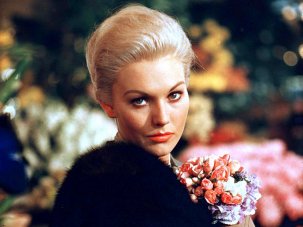
In our biggest ever film critics’ poll, the list of best movies ever made has a new top film, ending the 50-year reign of Citizen Kane.
Wednesday 1 August 2012
-
The Digital Edition and Archive quick link
Log in here to your digital edition and archive subscription, take a look at the packages on offer and buy a subscription.




